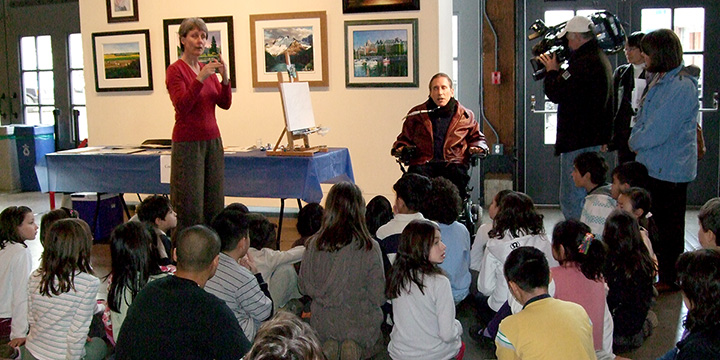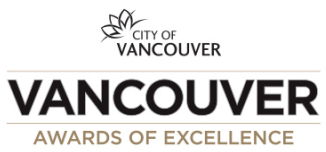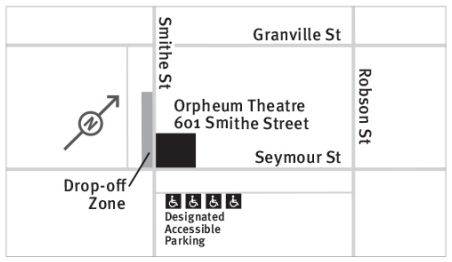

On this page
- Planning
- Choosing accessible venues
(Includes: entrances, pathways, corridors, doors, elevators, lighting, ventilation, acoustics, surfaces, washrooms, stages, parking, and signage) - Event on-site operations and assistance
(Includes: seating, tables, desks, and on-site assistance) - Displays and exhibits
- Food and beverage
- Staff and volunteer training
- Event and meeting materials, presentations and attendees
- Assistance dogs
- Promotion and invitations
(Includes: sample invitation) - Resources
(Includes: guides, agencies, and trans*, gender-variant, and two spirit inclusion)
Planning
- Provide any contractors with a copy of these accessibility guidelines and clearly communicate that, although it is not a legal term of the contract, you expect that contractors will adhere to the guidelines wherever possible
- Involve individuals such as persons with disabilities and trans* and gender-variant individuals in the early stages of your event planning
- Consider accessibility requirements for a variety of needs, including sensory, communications, chemical sensitivity, and mobility needs
- Consider accommodation of a variety of needs, including assistance dogs, walkers, wheelchairs, scooters, and strollers
- Plan your event as far ahead as possible (especially large events), preferably four weeks or more, to:
- Allow enough time for attendees to arrange HandyDART transportation and accompanying assistants. HandyDART users require at least a week’s advance notice to book a trip. It can take from one to three weeks for people to arrange for assistants.
- Arrange any on-site services needed, such as American Sign Language (ASL) interpretation. It takes at least two weeks to arrange for on-site assistance such as ASL.
- Arrange for Braille transcription at least 4 weeks before your event.
- Provide an ASL interpreter, especially for events with more than 100 people
- Provide real-time captioning, especially for events with more than 100 people, and ensure your site has technology to support this
- Check that emergency evacuation procedures are in place for all individuals, including people with disabilities and seniors
Choosing accessible venues
- Schedule an on-site visit before you reserve the venue
- Invite individuals with various needs, such as mobility and sensory needs, in your on-site visit
- Consider the timing of your event, avoiding early morning and late evening, if possible
- Many seniors/elders and people with disabilities need assistance, which is often difficult to arrange early and late in the day
- Limit external noise
Entrances, exits, pathways, hallways, corridors
- Clearly marked
- Turning space with a six-foot diameter
- Minimum 39 inches wide
- Free of any impediments or tripping hazards
- Preferably no lip or a maximum lip of one-half inch beveled
- Smooth, level surface with no stairs
- Avoid slopes where possible (no more than 5% slope)
- Well-marked paths at entrances with information about accessibility throughout the trail or path (for example, identify any interruptions of the accessible surface, such as steps, steep slopes, and so on)
Doors
- Ensure automatic door openers are activated (otherwise, wedge the door open if allowed by fire regulations)
Elevators
- Minimum 36-inch opening
- Large enough to accommodate a person with motorized wheelchair or scooter, and an attendant or assistance dog
Lighting
- Avoid dark and muted venues
- Ensure adequate lighting in parking locations, venue, and so on
- Avoid use of strobe lighting (it can trigger a seizure for people with epilepsy)
Ventilation
- Ensure ventilation of fresh outside air so people with chemical sensitivities are more comfortable
- Be aware of any ongoing construction or remodeling that could impact the circulation of air-borne allergens such as dust, paint fumes
Acoustics
- Consider the impact of ambient noise for people hard-of-hearing
Surfaces
- Level and smooth
- Concrete, asphalt, compacted crushed granite or limestone, linoleum, and tight-weave carpets without underlay
- Grass is not accessible when wet
- Wood chips or bark mulch are not accessible surfaces
- Drain rock is not an accessible surface
- Avoid slopes where possible (no more than 5% slope)
Washrooms
- Scent-free soap and flowers
- Signage asking attendees to not use scented products
- Washrooms and change rooms are trans* inclusive
- At least one washroom large enough to accommodate a person with a motorized wheelchair and their attendant
- At least one single-user washroom with signage to reflect universal, functions-based designation
- For outdoor events, provide wheelchair-accessible portable toilets and ensure that people using motorized or manual wheelchairs can get to them on accessible surfaces
Stages
- Stage entrance must be level, gently sloping, ramped, or have a lift
- Ramp slopes no more than 5%
- Provide a stand-alone microphone (wireless or with an adjustable stand) for people who need to sit or use mobility devices
- Podiums are at least one metre away from the stage edge, to prevent accidents and falls for speakers who are blind or partially sighted, who may not be able to see the end of the stage
- Lecterns can adjust to different heights for people who need to sit or use mobility devices, or use two lecterns with different heights
Pathways
- Pathways to displays, stages, speaker’s podium should be minimum 39 inches wide, and include turning circle space with a diameter of 6 feet
- Pathway slopes no more than 5%
- Consider tripping hazards, obstacles, stairs, curbs, and bumps that would prevent people using wheelchairs, walkers, or canes from navigating the pathway
Parking and pick-up/drop-off
- Minimum 2% of total parking available should be accessible and at least 4 spaces more than anticipated
- Spaces should be at least 8.5 feet wide with adjacent side and rear access of at least 6.6 feet wide
- Two accessible parking spaces may share a common access aisle
- Clearly marked location for HandyDART and taxi
- Ensure there is clear access to the HandyDART pick-up location after the event ends, until all attendees waiting for HandyDART have been picked up
Signage
- Clearly and visibly signed accessible entrances, parking, washrooms, public phones, transit points, and other conveniences
- Install standard universal signage in single-user washrooms, change booths, and other spaces
- Translate existing signage with multiple languages to increase understanding and avoiding confusion among users
- Avoid using gender symbols of bodies and focus on function symbols
- Use high contrast colours – light text on dark background or dark text on light background
- Use a text size of at least 14 point and sans serif font, such as Arial
- Provide signage e in three formats if possible – tactile graphics, tactile lettering, and Braille
- Place signage at eye level for people seated in mobility devices (1.2 m from the floor, based on the City of Toronto standard)
- Ensure signage does not block sidewalks or create a trip hazard
On-site operations and assistance during your event
Seating
- Avoid designating a single area “for wheelchair use” – this segregates and stigmatizes individuals using wheelchairs, prevents them from having the same choices as other attendees, and prevents them from being seated with friends
and colleagues - Provide sufficient places with no seats for people in wheelchairs or scooters to use. If possible, scatter these throughout the venue
- Where seats are movable, provide areas by the aisles with no chairs so people with mobility aids can maneuver into these spaces
- Ensure aisles between seating rows are wide enough for people using mobility aids – a minimum 36 inches of clear space
- Provide seats near the front of the room for people with visual or hearing needs with clear access to ASL interpreters and speakers
- Ensure there are chairs directly in front of the real-time captioning screen for people who are deaf or hard of hearing
Tables
- Provide sufficient space between tables for people using mobility devices and assistance dogs to go between
- Ensure the space between occupied chairs from adjacent tables is at minimum 36 inches
- Have one chair missing from each table for people using mobility aids
Counters and reception desks
- Ensure desks are 29 to 34 inches from the floor, to ensure people using mobility aids can access the desks
On-site assistance
- American Sign Language (ASL) interpreters – reserve space on stage and microphone for interpreters when speaking for a deaf person
- Real-time captioning – provide a large screen in front of room and seats provided in the front for people who are deaf or hard of hearing
- Provide interpreters and real-time captioning with prior information on program content and length, copies of speaker notes, and PowerPoint presentations, titles, and any technical language or unique features
- Arrange escorts to the stage for attendees who are blind or partially sighted. Escorts should communicate where the edge of the stage is and stay with the attendees to escort them to and from the stage
- Consider language translation
- Consider assistive hearing devices, Vocal Eye described audio, and accessible outdoor surface, such as Mobi-Mats (portable mats that make the ground more accessible and smooth)
Displays and exhibits
- Consider the display height so they're accessible to people using wheelchairs or scooters
- For guidance, refer to the Smithsonian Guidelines for Accessible Exhibition Design

- For guidance, refer to the Smithsonian Guidelines for Accessible Exhibition Design
Food and beverage
- Accommodate food sensitivities and dietary requests
- Label accommodated meals
- Consider serving accommodated meals first in case a correction is needed, however, be mindful that all attendees want to enjoy their meals at the same time
- Offer non-plastic containers and bendable straws
- Clearly label ingredients
- Provide water, and provide help pouring
- Avoid sharp objects such as toothpicks
- Communicate dietary accommodations to caterers, and ensure they follow through
Staff and volunteer training
- Designate a person trained on accessibility issues as a resource to staff, volunteers, and attendees for any questions, issues, or emergencies both before and during the event
- Provide orientation to all staff and volunteers, including ushers on accessibility features of the event venue
- Provide training on assisting seniors/elders and people with disabilities about seating, mobility, bathroom, food, drink, getting items, and escorting to the stage
- Ensure emergency evacuation procedures are known and assign specific individuals to assist people with disabilities and seniors
- If food is served buffet-style, ensure that food ingredients are well labelled or that staff and volunteers know the ingredients
- Develop and introduce a trans* and gender-variant inclusion information session for staff and contractors
Event materials, presentations, and attendees
- Use non-toxic materials, such as unscented markers and non-plastic name badges
- Use high contrast colours – light text on dark background or dark text on light background
- Use a text size of at least 14 point and sans serif font, such as Arial
- Offer materials and agendas in advance, in digital, large print or Braille formats if requested
- Consider using captions and audio descriptions for videos
- Ask speakers and presenters to verbally describe any visual content in their presentations
- Ask speakers and attendees to identify themselves by name each time they speak for the benefit of visually-impaired individuals
- Ask speakers and attendees how they want to be referred to – by name or pronoun. Pronouns may be either feminine (she, her, hers), masculine (he, him, his) or gender-neutral (they, them, theirs)
- Welcome participants using gender-neutral terms (such as people or folks) – not ladies and gentlemen or guys
Assistance dogs
- Designate an outdoor toilet space
- Provide a waste bin
- Provide water bowls
Promotion and invitations
- Communicate your event broadly using multiple methods, such as email, radio, website, social media, direct mail, posters at public buildings, and circulation to specific groups such as seniors and disability groups
- Website conforms to WCAG 2.0 accessibility standards
- Use a text size of at least 14 point and sans serif font, such as Arial
- Include contact information (phone, email, TTY) on all materials so attendees can request assistance when they RSVP, and specify how far in advance the request needs to be made, or any additional information or questions.
- For example, you could say: If you require any assistance related to disability, communications, accessibility or dietary restrictions, please include this information in your RSVP by (date), or contact (name/ phone/ email/ TTY) by (date).
- Include information on accessibility features, such as ASL interpreters, real-time captioning, closed loop audio systems, dietary accommodation, non-toxic materials and accessible entrances and parking, as well as a map on how to get to the event with pick-up/drop-off locations
- Notify attendees at least four weeks in advance so they can arrange for transportation and attendants
- Ask attendees to not wear scented products
- For example, you could say: We encourage everyone to help maintain a scent-free environment(no perfumes, scented soaps, or scented lotions)
- Avoid embedding essential information in graphic formats because they can't be read out to people using assistive technology such as screen readers
- Use captions and audio descriptions for videos
Sample invitation

Important information
If you require any assistance related to accessibility or dietary restrictions, please include this information in your RSVP or contact [staff] at [email address] or [phone number].
Drop-off zone and designated accessible parking are available at specially marked meters (see the map below).
We encourage everyone to help maintain a scent-free environment.

Resources
Accessible publication design
Smithsonian Guidelines for Accessible Publication Design ![]()
Accessible events
Measuring Up: Accessible Public Event Guidelines ![]()
Accessible exhibition design
Smithsonian Guidelines for Accessible Design ![]()
American Sign Language (ASL) interpretation
Western Institute for the Deaf and Hard of Hearing (WIDHH) ![]()
The Westcoast Association of Visual Language Interpreters ![]()
Described audio for visually-impaired people
VocalEye Descriptive Arts Society ![]()
Organizations
Canadian National Institute for the Blind (CNIB) ![]()
Cerebral Palsy Association of British Columbia (CPABC) ![]()
Canadian Mental Health Association (CMHA) ![]()
Greater Vancouver Association of the Deaf and Hard of Hearing (GVAD): [email protected]
Learning Disabilities Association Vancouver ![]()
Neil Squire Society (computer-based assistive technologies) ![]()
The Social Planning and Research Council of BC (SPARC BC) ![]()
Real-time captioning
The Canadian Hard of Hearing Association (CHHA-BC Resource Centre) ![]()
Two-spirit, trans, and gender-diverse inclusion
Staff report: Supporting Trans Equality and an Inclusive Vancouver ![]() (1.5 MB)
(1.5 MB)
